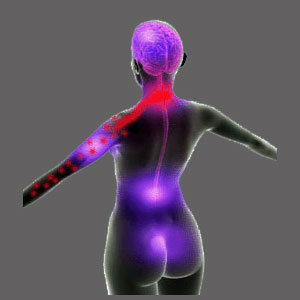
The layman’s term pinched nerves is a diagnostic conclusion which means different things to different people, depending on where in the body it may occur. Regardless of how the condition is actually defined, the incidence of incorrect diagnosis is at epidemic proportions and treatment is commonly ineffectual. For the purposes of this article, the condition will be defined classically, as a compressed spinal nerve root due to neuroforaminal stenosis, as opposed to nerve compression which may take place in other areas of the anatomy due to muscular or other soft tissue concerns. This is the textbook definition of a compressive neuropathy in its purest form and the one most often implicated in back and neck pain syndromes.
Hopefully, this discussion will help you to better understand a compressive neuropathy diagnosis and might even assist you in making sure the diagnostic theory is valid through symptomatic correlation.
Definition of Pinched Nerves
The spinal cord runs through the central canal space and from this cord, the spinal nerve roots branch off at each vertebral level. When these nerve roots separate off from the spinal cord, they must exit the spinal canal in order to go off into the body and form the network of nerves which control all our motor, sensory and autonomic functionalities.
First, the nerve travels through the lateral recess and can sometimes fall victim to lateral recess stenosis in very rare cases. Far more often, the nerve may suffer compression as it enters the foraminal opening. This is the anatomical doorway that the nerve must travel as it frees itself from the spinal canal. The process by which a narrowed opening causes the nerve to become compressed is called neuroforaminal stenosis, or simply, foraminal stenosis.
For a visual, picture trying to get through a doorway while the door is progressively closing. This is foraminal stenosis and you are the nerve.
Causes of Compressed Nerves
There are many potential causes of foraminal stenosis to occur. These can be related to back injury, spinal degeneration or sourced by congenital or developmental abnormalities in the spinal anatomy. Here are most of the common sources of nerve root compression in the spine:
Herniated discs can cause nerves to become pinched in rare cases.
Scoliosis can cause nerves to become trapped in narrowed foraminal openings.
Spondylolisthesis, and other spinal misalignment issues, can pinch nerves in between poorly aligned bones.
Spinal osteoarthritis can create debris and bone spurs in the foraminal spaces, or central canal, compressing nerve roots.
Any process which will cause the decrease of foraminal size may contribute to a pinched neurological structure.
Facts of Spinal Stenosis Pinched Nerves
When it comes to spinal stenosis, there are 3 distinct types which can cause compressive neuropathy conditions to occur:
The first, neuroforaminal stenosis, was already discussed and presents the traditional diagnosis for true impinged nerves.
The second, central canal stenosis, will usually cause compressed nerves in the lumbar region, since the cauda equina is divided at that point and the nerve roots are free within the central canal space.
The last, lateral recess stenosis, is much more controversial and is diagnosed far more than it truly exists. However, in some cases, it is clear that nerves can suffer impingement and even compression inside the lateral recess in extreme circumstances.
To learn more about any diagnosed nerve compression condition, talk to your neurologist. Remember, it is possible for soft tissues to also impinge on nerve tissue in the spine, such as in the case of ligament hypertrophy; or elsewhere in the anatomy, such as in thoracic outlet syndrome or piriformis syndrome.
The efficacy of our proprietary pain relief program has proven that many pinched nerves are misdiagnosed. After all, the program does not change the spinal anatomy, but it is still incredibly effective at ending pain. This is why the program has been honored by so many doctors and international healthcare organizations. It is also 100% safe and holistic.
Spinal Stenosis > Neuroforaminal Stenosis > Pinched Nerves





